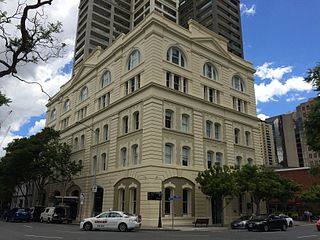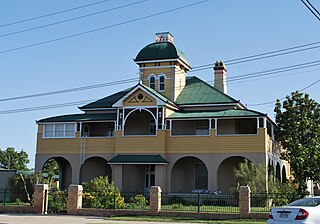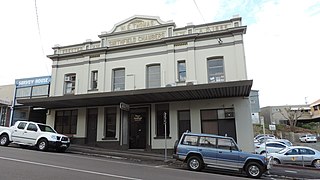
Regatta Hotel is a heritage-listed hotel at 543 Coronation Drive on the corner of Sylvan Road, Toowong, City of Brisbane, Queensland, Australia. It faces the Toowong Reach of the Brisbane River and was named after the rowing regattas held there. It was designed by Richard Gailey and built in 1886 by George Gazzard. It was added to the Queensland Heritage Register on 21 October 1992.

The Orient Hotel is a heritage-listed hotel at 560 Queen Street, Brisbane CBD, City of Brisbane, Queensland, Australia, on the corner of Ann Street. It was originally built as the Excelsior Hotel in 1875 and extended in 1884, both of which were designed by Brisbane architect Richard Gailey. It was added to the Queensland Heritage Register on 23 April 1999.

The Palings Building is a heritage-listed retail building located at 86 Queen Street, Brisbane City, City of Brisbane, Queensland, Australia. It was designed by Richard Gailey as one of a row of four identical buildings and built from 1885 to 1919 by Patten & Son. Two of the four buildings have since been demolished while a third survives but is incorporated into another building. The Palings building was added to the Queensland Heritage Register on 21 October 1992; at that time, the building was used for the City International Duty Free store.

Baptist City Tabernacle is a heritage-listed church at 163 Wickham Terrace, Spring Hill, Brisbane, Queensland, Australia. It was designed by Richard Gailey and built from c. 1889 to 1890. It was added to the Queensland Heritage Register on 21 October 1992.

Wickham Hotel is a heritage-listed hotel at 308 Wickham Street, Fortitude Valley, City of Brisbane, Queensland, Australia. Originally trading as the Oriental, it was designed by Richard Gailey and built in 1885 by Cussack & O'Keefe. It was added to the Queensland Heritage Register on 21 October 1992.

Prince Consort Hotel is a heritage-listed hotel at 230 Wickham Street, Fortitude Valley, City of Brisbane, Queensland, Australia. It was designed by Richard Gailey and built from 1887 to 1888 with later extensions. It was added to the Queensland Heritage Register on 21 October 1992. In 2014, it is trading as the Elephant Hotel.

Jubilee Hotel is a heritage-listed hotel at 464–468 St Pauls Terrace, Fortitude Valley, City of Brisbane, Queensland, Australia. It was designed by Richard Gailey and built from 1887 to 1888. It was added to the Queensland Heritage Register on 21 October 1992.

Woolloongabba Police Station is a heritage-listed former police station at 842–848 Main Street, Woolloongabba, City of Brisbane, Queensland, Australia. It was designed by the Queensland Department of Public Works and built from 1913 to 1936. It is also known as South Coast District Headquarters and Woolloongabba Police Station. It was added to the Queensland Heritage Register on 25 November 1994.

The Phoenix Buildings are heritage-listed commercial buildings at 647 Stanley Street, Woolloongabba, City of Brisbane, Queensland, Australia. They were designed by Richard Gailey and built from 1889 to 1890 by James Rix. They were added to the Queensland Heritage Register on 24 May 1995.

Empire Hotel is a heritage-listed hotel at 339 Brunswick Street, Fortitude Valley, City of Brisbane, Queensland, Australia. It was designed by Richard Gailey and built in 1888 by Smith and Ball. It was renovated in 1925 to a design by Richard Gailey, Junior. It was further renovated in 1937 to incorporate apartments designed by Hall and Phillips. It was added to the Queensland Heritage Register on 21 October 1992.

Old Mineral House is a heritage-listed warehouse at 2 Edward Street, Brisbane City, City of Brisbane, Queensland, Australia. It was designed by Richard Gailey and built from 1888 to 1890s by William Anthony. It is also known as Smellie & Co Warehouse and the Industrial High School. It was added to the Queensland Heritage Register on 21 October 1992.

Watson Brothers Building is a heritage-listed warehouse at 129 Margaret Street, Brisbane City, City of Brisbane, Queensland, Australia. It was designed by Richard Gailey and built from 1887 to 1918. It was added to the Queensland Heritage Register on 23 April 1999.

The Queensland Country Life Building facade is a heritage-listed facade of a former warehouse at 424–426 Queen Street, Brisbane City, City of Brisbane, Queensland, Australia. It was designed by Richard Gailey and built from 1888 to 1889 by George Gazzard. It is also known as Hill's Buildings. It was added to the Queensland Heritage Register on 21 October 1992.

St Mary's Presbytery is a heritage-listed Roman Catholic presbytery of St Mary's Roman Catholic Church at 142 Palmerin Street, Warwick, Southern Downs Region, Queensland, Australia. It was designed by Wallace & Gibson and built from 1885 to 1887 by John McCulloch. It is also known as Father JJ Horan's private residence. It was added to the Queensland Heritage Register on 31 July 2008.

The Bank of New South Wales is a heritage-listed former bank at 242 Mary Street, Gympie, Gympie Region, Queensland, Australia. It was designed by Richard Gailey and built from 1890 to 1891 by T. Kelly. It is also known as Widgee Shire Council Chambers, Coolooa Shire Council Chambers and Gympie Regional Council Chambers. It was added to the Queensland Heritage Register on 15 April 2011.

Smithfield Chambers is a heritage-listed office building at 235 Mary Street, Gympie, Gympie Region, Queensland, Australia. It was designed by Leslie Gordon Corrie and built in the 1890s by William Anthony. It was added to the Queensland Heritage Register on 15 July 2011.

Tozer's Building is a heritage-listed office building at 218 Mary Street, Gympie, Gympie Region, Queensland, Australia. It was designed by Richard Gailey and built in 1896. It is also known as Jeffery & Cuddihy Building. It was added to the Queensland Heritage Register on 15 July 2011.

The National Australia Bank is a heritage-listed bank building at 61 Churchill Street, Childers, Bundaberg Region, Queensland, Australia. It was designed by Hubert George Octavius Thomas and built c. 1900. It is also known as Bank of North Queensland, Bank of Queensland, and National Bank of Australasia. It was added to the Queensland Heritage Register on 21 October 1992.

Walter Reid Community Arts Centre is a heritage-listed former warehouse and now community arts centre at 203 East Street, Rockhampton, Rockhampton Region, Queensland, Australia. It was designed by Hutton & Hockings and built from 1900 to 1902 by Dennis Kelleher. It is also known as Walter Reid & Co. It was added to the Queensland Heritage Register on 21 October 1992.

Commonwealth Offices is a heritage-listed commercial building at 42 Sturt Street, Townsville CBD, City of Townsville, Queensland, Australia. It was built from 1884 to 1889. It has also known as D & W Murray Ltd Building, Rooneys Ltd Building and Scott, Dawson & Stewart Building. As at March 2016, it is known as Federation Place. It was added to the Queensland Heritage Register on 15 June 1994.





















